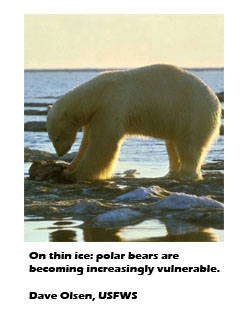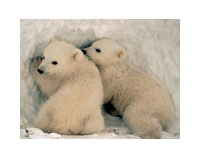United States focuses on polar bears' plight
 The United States has admitted what conservationists have been saying for years — that the polar bear is in danger of losing its battle with habitat loss. A new government proposal suggests that the species be listed as ‘threatened’ as a result of melting Arctic ice.
The United States has admitted what conservationists have been saying for years — that the polar bear is in danger of losing its battle with habitat loss. A new government proposal suggests that the species be listed as ‘threatened’ as a result of melting Arctic ice.Under the plan, unveiled by Secretary of the Interior Dirk Kempthorne yesterday, the US Fish and Wildlife Service will spend a year evaluating the status of the polar bear. If it is listed as threatened, it will come under the protection of the US Endangered Species Act, which sets out recovery plans for endangered wildlife.
“Based on current analysis, there are concerns about the effect of receding sea ice on polar bear populations,” Kempthorne said in his announcement. There are thought to be fewer than 25,000 polar bears (Ursus maritimus) remaining.
Summer sea ice has been receding by an average of 7.7% per decade since 1978, Kempthorne’s report says. Other US reports have shown that the rate of melt is accelerating (see ‘Arctic clear for summer sailing by 2040’) . Although bear numbers on US territory in Alaska have not declined significantly in recent decades, some populations in neighbouring Canada have dwindled by 22% between 1987 and 2004, and conservationists fear that the US bears could follow suit.
“Based on current analysis, there are concerns about the effect of receding sea ice on polar bear populations”, says Dirk Kempthorne US Secretary of the Interior.
Climate concern

Observers are recognizing the move as notable for linking climate change with a decline in a species. The announcement states that an evaluation of the causes of climate change are “beyond the scope of the review process”.
Other bodies have already recognized the plight of the polar bear. In May of this year, the IUCN, the international conservation organization, upgraded the polar bears’ status to ‘vulnerable’ on its Red List — widely viewed as the definitive word on the world’s threatened species (see ‘Polar bears sink deeper into danger’), although inclusion on this list does not necessarily guarantee that conservation action will be taken by national governments.
Polar bears are already protected by the 1972 Marine Mammal Protection Act, which bans the killing of these animals or their transport across international borders. President George W. Bush is also expected to sign an act, passed by Congress earlier this month, between the United States and Russia to conserve and manage polar bears that roam across both of their territories.
If Kempthorne’s proposal is accepted after a period of public comment, the government will draw up a recovery plan for the bears, and will calculate sustainable levels of hunting by native people. The Endangered Species Act also calls for the protection of species’ habitats — although in the case of melting sea ice this may be a difficult proposition.
You can return to the main Market News page, or press the Back button on your browser.

